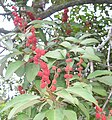Note: This is a project under development. The articles on this wiki are just being initiated and broadly incomplete. You can Help creating new pages.
Difference between revisions of "Mallotus philippensis - Kamala tree"
(→External Links) |
(→Parts Used) |
||
| Line 7: | Line 7: | ||
==Parts Used== | ==Parts Used== | ||
| − | {{Parts Used|Fruits}}, {{Parts Used| | + | {{Parts Used|Fruits}}, {{Parts Used|Stem}}, {{Parts Used|Leaves}}, {{Parts Used|Root}}. |
==Chemical Composition== | ==Chemical Composition== | ||
Revision as of 13:35, 25 November 2020
Mallotus philippensis or Kampillaka or Kumkumada mara is a tree that bears fruits which give out red coloured powder which is used as a dye. The dye is known for its anthelmintic properties[1].
Contents
- 1 Uses
- 2 Parts Used
- 3 Chemical Composition
- 4 Common names
- 5 Properties
- 6 Habit
- 7 Identification
- 8 List of Ayurvedic medicine in which the herb is used
- 9 Where to get the saplings
- 10 Mode of Propagation
- 11 How to plant/cultivate
- 12 Commonly seen growing in areas
- 13 Photo Gallery
- 14 References
- 15 External Links
Uses
Anthelmintic.[2] As remedy for tape-worm, because of its laxative effect.
Parts Used
Chemical Composition
[3] Rottlerin, mallotoxin
Common names
| Language | Common name |
|---|---|
| Kannada | |
| Hindi | Kamala |
| Malayalam | |
| Tamil | |
| Telugu | |
| Marathi | |
| Gujarathi | |
| Punjabi | |
| Kashmiri | |
| Sanskrit | |
| English | Kamala tree, Monkey Face Tree |
Properties
Reference: Dravya - Substance, Rasa - Taste, Guna - Qualities, Veerya - Potency, Vipaka - Post-digesion effect, Karma - Pharmacological activity, Prabhava - Therepeutics.
Dravya
Rasa
Guna
Veerya
Vipaka
Karma
Prabhava
Habit
Identification
Leaf
| Kind | Shape | Feature |
|---|---|---|
| Leaves are opposite on the stem | Ovate to oblong in shape. 4 to 12 cm long, 2 to 7 cm wide with a long pointed tip. | The upper surface is green without hairs, the underside pale grey in colour. With a magnifying glass, small red glands may be visible. Leaf stems 2 to 5 cm long, somewhat thickened at both ends. The first leaf vein on either side of the mid rib extends from the leaf base, to over half the length of the leaf. Veins raised and evident under the leaf. |
Flower
| Type | Size | Color and composition | Stamen | More information |
|---|---|---|---|---|
| Yellow-brown flowers form on racemes. Racemes up to 6 cm long. | Male and female flowers grow on separate trees. | New South Wales flowering period is from June to November. Flowering period in the Philippines is March to April | {{{5}}} |
Fruit
| Type | Size | Mass | Appearance | Seeds | More information |
|---|---|---|---|---|---|
| 6 to 9 mm broad | covered in red powdery substance | seeds 2 to 3 mm in diameter | Fresh seed is advised for germination. | {{{6}}} |
Other features
List of Ayurvedic medicine in which the herb is used
Where to get the saplings
Mode of Propagation
How to plant/cultivate
A plant of lower elevations in the tropics, where it can be found from sea level to 1,600 metres. It grows best in areas where annual daytime temperatures are within the range 25 - 34°c, but can tolerate 7 - 45°c. When dormant, the plant can survive temperatures down to about -2°c, but young growth can be severely damaged at 0°c. It prefers a mean annual rainfall in the range 1,000 - 2,500mm, but tolerates 600 - 5,000mm. Succeeds in full sun, but plants can also tolerate considerable shade. Prefers a pH in the range 5 - 6.7, tolerating 4.5 - 7.5. Established plants are drought tolerant. The growth is comparatively slow - mean annual girth increment being reported in India at 0.65 cm, with a mean girth after 16 years of less than 15cm. [5]
Commonly seen growing in areas
South Asia, Southeast Asia, Afghanistan and Australia, Mount Keira, south of Sydney.
Photo Gallery
Red kamala at its most southerly point of natural distribution, Mount Keira, Illawarra, Australia
Black-crested bulbul feeding on the red kamala at Jayanti, India
References
- ↑ Template:Cite journal
- ↑ Indian Medicinal Plants by C.P.Khare
- ↑ ["Chemistry"]
- ↑ ["Morphology"]
- ↑ "Cultivation"
External Links
- Ayurvedic Herbs known to be helpful to treat Anthelmintic
- Herbs with Fruits used in medicine
- Herbs with Stem used in medicine
- Herbs with Leaves used in medicine
- Herbs with Root used in medicine
- Herbs with common name in Hindi
- Herbs with common name in English
- Habit - Seeds
- Habit - Cutting
- Index of Plants which can be propagated by Seeds
- Herbs that are commonly seen in the region of South Asia, Southeast Asia
- Herbs that are commonly seen in the region of Afghanistan and Australia
- Herbs that are commonly seen in the region of Mount Keira, south of Sydney
- Herbs




